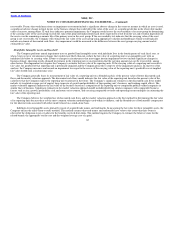Nike 2010 Annual Report Download - page 68
Download and view the complete annual report
Please find page 68 of the 2010 Nike annual report below. You can navigate through the pages in the report by either clicking on the pages listed below, or by using the keyword search tool below to find specific information within the annual report.
Table of Contents NIKE, INC.
NOTES TO CONSOLIDATED FINANCIAL STATEMENTS — (Continued)
In April 2009, the FASB updated guidance related to fair value measurements to clarify the guidance related to measuring fair value in inactive
markets, to modify the recognition and measurement of other−than−temporary impairments of debt securities, and to require public companies to disclose
the fair values of financial instruments in interim periods. This updated guidance became effective for the Company beginning June 1, 2009. The adoption
of this guidance did not have an impact on the Company’s consolidated financial position or results of operations. See Note 6 — Fair Value Measurements
for disclosure required under the updated guidance.
In June 2008, the FASB issued new accounting guidance applicable when determining whether instruments granted in share−based payment
transactions are participating securities. This guidance clarifies that share−based payment awards that entitle their holders to receive non−forfeitable
dividends before vesting should be considered participating securities and included in the computation of earnings per share pursuant to the two−class
method. This guidance became effective for the Company beginning June 1, 2009. The adoption of this guidance did not have a material impact on the
Company’s consolidated financial position or results of operations.
In April 2008, the FASB issued amended guidance regarding the determination of the useful life of intangible assets. This guidance amends the
factors that should be considered in developing renewal or extension assumptions used to determine the useful life of a recognized intangible asset. The
intent of the position is to improve the consistency between the useful life of a recognized intangible asset and the period of expected cash flows used to
measure the fair value of the asset. This guidance became effective for the Company beginning June 1, 2009. The adoption of this guidance did not have a
material impact on the Company’s consolidated financial position or results of operations.
In December 2007, the FASB issued amended guidance regarding business combinations, establishing principles and requirements for how an
acquirer recognizes and measures identifiable assets acquired, liabilities assumed, any resulting goodwill, and any non−controlling interest in an acquiree in
its financial statements. This guidance also provides for disclosures to enable users of the financial statements to evaluate the nature and financial effects of
a business combination. This amended guidance became effective for the Company beginning June 1, 2009. The adoption of this amended guidance did not
have an impact on the Company’s consolidated financial statements, but could impact the accounting for future business combinations.
In December 2007, the FASB issued new guidance regarding the accounting and reporting for non−controlling interests in subsidiaries. This guidance
clarifies that non−controlling interests in subsidiaries should be accounted for as a component of equity separate from the parent’s equity. This guidance
became effective for the Company beginning June 1, 2009. The adoption of this guidance did not have an impact on the Company’s consolidated financial
position or results of operations.
Recently Issued Accounting Standards:
In October 2009, the FASB issued new standards that revised the guidance for revenue recognition with multiple deliverables. These new standards
impact the determination of when the individual deliverables included in a multiple−element arrangement may be treated as separate units of accounting.
Additionally, these new standards modify the manner in which the transaction consideration is allocated across the separately identified deliverables by no
longer permitting the residual method of allocating arrangement consideration. These new standards are effective for the Company beginning June 1, 2011.
The Company does not expect the adoption will have a material impact on its consolidated financial positions or results of operations.
In June 2009, the FASB issued a new accounting standard that revised the guidance for the consolidation of variable interest entities (“VIE”). This
new guidance requires a qualitative approach to identifying a controlling financial interest in a VIE, and requires an ongoing assessment of whether an
entity is a VIE and whether an
65
























